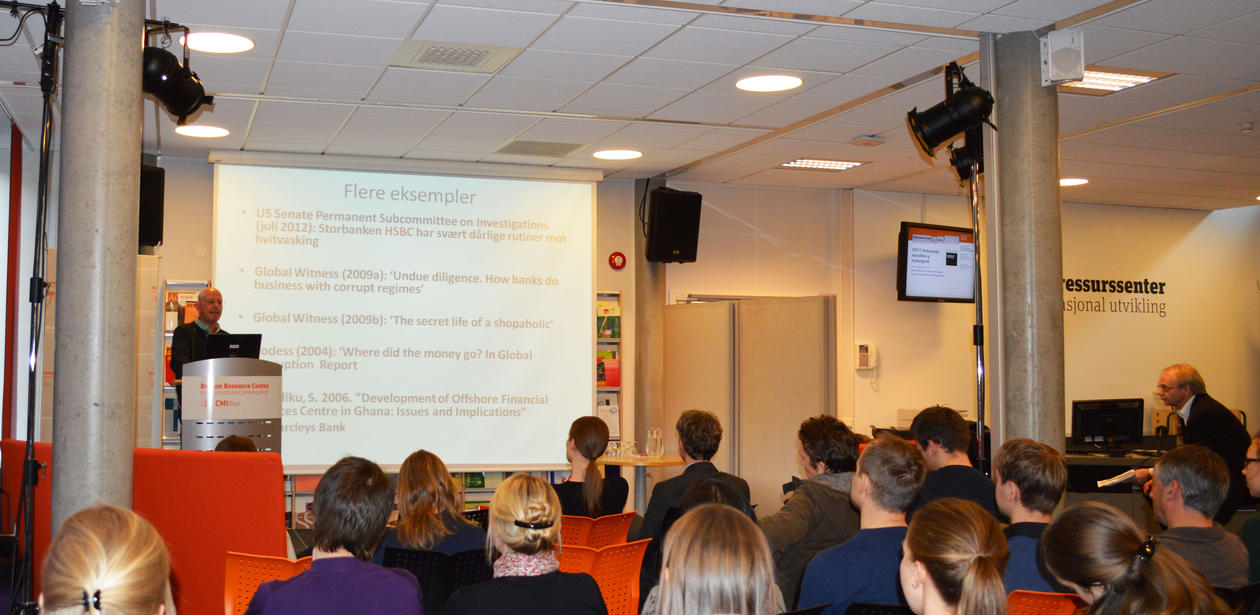A Life’s Work: Building Norway’s Largest Library on Development Studies
The leader of the CMI library and the Bergen Resource Centre for International Development has retired after more than forty years, but students, researchers and the public will continue to enjoy the fruits of her labour.
Hovedinnhold
Kirsti Hagen Andersen started working at the Chr. Michelsen Institute (CMI) in 1970, becoming its head librarian in 1972. At the time CMI was a very different place:
– When I came to CMI the book collection numbered around five thousand volumes, and there were only economists who did development research. Then gradually the other social sciences got involved, and CMI started working on developing projects and developing countries. Bangladesh was the first country we cooperated with, which led us to build a large book collection on Bangladesh and Pakistan. Research moved on from there, mostly following the Norwegian funding for development projects. This led to a predominance of literature on Africa, as this continent was the focus of Norad’s activities, says Andersen.
Expanding to new topics and regions
When CMI moved to more spacious localities at Fantoft in 1978, Andersen had the chance to be more proactive in building the library’s repository:
– We tried building collections on several topics and all countries, including those with whom there was no collaboration at the time. If suddenly a new country or topic came into focus, we would then have a basic collection of literature for research. This strategy proved to be very useful, as we were prepared when topics such as the green revolution, women in developing countries and human rights appeared on the research agenda, says Andersen.
A new chapter at the Resource Centre
In 2009 the Bergen Resource Centre for International Development opened its doors. The centre is run jointly by CMI and the University of Bergen, and the collaboration has proven fruitful.
– CMI transferred its library to the Resource Centre in 2009. We have an impressive collection of literature on Sudan, owing to two significant collections which we have here at the library. Professor Knut Vikør at the Centre for Middle Eastern Studies at UiB has donated his personal collection, and the Sudanese businessman Mahmoud S.O. Salih has found a temporary home for his Sudan Collection here at the Resource Centre. This collection is unrivalled in the world. Until an appropriate location can be found in Sudan, we keep the books in the library, where a large number of them are being scanned and digitalised for free downloading on the web, says Andersen.
From 5000 books in 1970 the library at the Resource Centre has grown to 80,000 volumes and 300 periodicals. Andersen says that strengthening this impressive collection remains a priority. In addition to Africa, Asia and the Middle East, which are the main areas, Latin America needs to be strengthened and updated, because no Norwegian library has a good coverage on this region. Students and researchers can also suggest literature to be purchased by the library.
In the longer term there are also plans to digitise literature, making it accessible to partner institutions in the global south. Andersen has herself participated in librarian exchange programmes with these institutions, and would like to see a resumption of such programmes, which she says have been very fruitful in the past.
A centre for both UiB and CMI
Andersen emphasises that both researchers and students at the University of Bergen are welcome to make use of the library’s valuable resources:
– As this is a joint venture of CMI and UiB I want to stress that the literature is openly accessible to students and researchers at UiB, and that they can use their University Library cards to borrow books, many of which cannot be found elsewhere in the Bibsys portal. We also want them to make use of the reading hall at the Resource Centre.
The Bergen Resource Centre for International Development does not only contain Norway’s largest collection of development literature. It was also conceived as a meeting place for CMI and UiB researchers, students and the public, on issues of importance for international relations and development.
– The vision was to create a meeting place, a symbiosis between UiB and CMI, which has been accomplished through seminars. This has been a success beyond all expectations. We have organised three hundred events since the beginning in late 2009. The breakfast seminars have been especially successful, as we have seen an increasing number of people coming to these events. Attendance is straightforward, as it is free without any form of registration. Other seminars and debates have also been very successful, and we have the financial means to invite prominent researchers from both Norway and abroad, says Andersen.
Organising an event at the Resource Centre is free of charge, and can be done by e-mail. Those who are interested in learning more about upcoming events can subscribe to the Resource Centre’s newsletter here.
Uncertainties about the future of the Resource Centre
Andersen’s position is currently not filled, which according to the retired leader is a cause for concern:
– In my view it is a catastrophe. The workload will be too great, and the Centre will be vulnerable to potential absences due to illness.
Andersen also stresses that when a new leader is in place, it needs to be someone with loyalty to both CMI and UiB, and who understands the need for the Resource Centre to be an open forum:
– People from both institutions need to feel that it is their arena. The door also needs to be open to other relevant institutions, such as the Norwegian School of Commerce, The Bjerknes Centre for Climate Research, the Directorate of Fisheries and the Institute of Marine Research, says Andersen, who was honoured with a seminar on the past and future of development research libraries, two weeks before her retirement.


